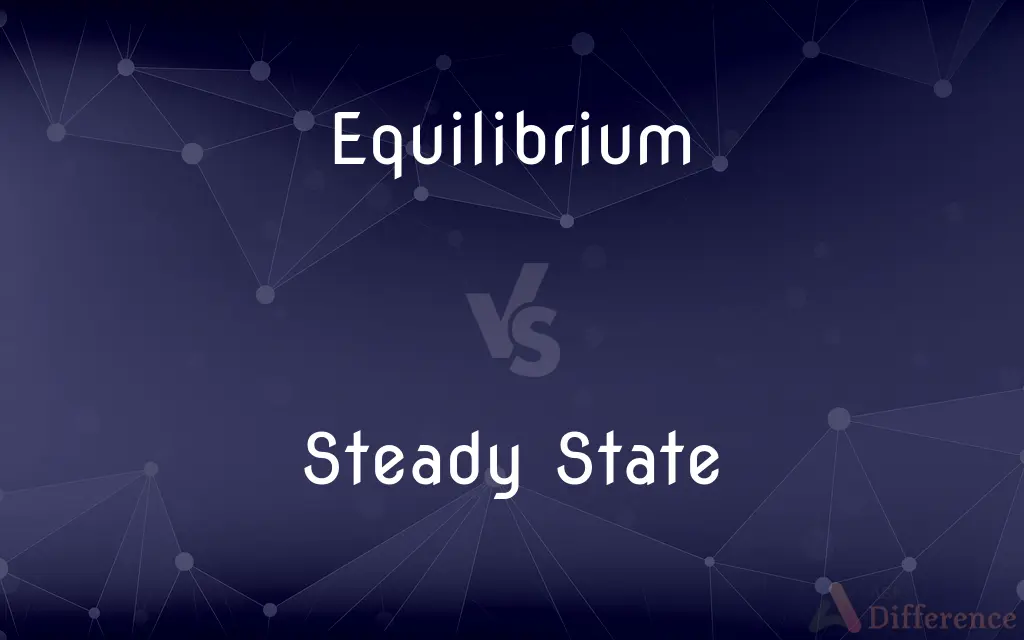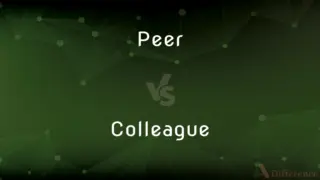Equilibrium vs. Steady State — What's the Difference?
By Tayyaba Rehman — Published on January 13, 2024
Equilibrium refers to a balanced state where opposing forces are equal, while a steady state denotes a consistent and unaltered condition maintained in a system over time.

Difference Between Equilibrium and Steady State
Table of Contents
ADVERTISEMENT
Key Differences
Equilibrium refers to a state of balance where opposing forces or influences are equal, resulting in no net change. It's often used in physics, chemistry, and economics to describe a condition where all acting influences are canceled out by others. In contrast, Steady State describes a consistent, unchanging condition in a system over time, often used in biology, ecology, and engineering to depict a system where variables remain constant despite ongoing processes.
In a state of Equilibrium, the system may not experience any movement or change because the opposing forces are balanced. For example, in a chemical reaction, Equilibrium is reached when the rate of the forward reaction equals the rate of the backward reaction. On the other hand, a Steady State implies constant motion or activity, but the overall conditions remain unchanged. In an ecosystem, a Steady State is achieved when birth rates equal death rates, keeping the population constant.
Equilibrium can be static or dynamic. In static Equilibrium, objects are at rest, and forces are balanced. In dynamic Equilibrium, objects are in motion, but there's no net change in their state. Steady State, however, always involves dynamic processes, such as the continuous flow of energy or matter, but the system's overall properties don't change over time.
The concept of Equilibrium often involves the idea of restoration. If disturbed, a system in Equilibrium tends to return to its original state. In contrast, a Steady State doesn't necessarily have this restorative property. If a Steady State system is disturbed, it might not return to its previous state without external intervention.
Understanding the difference between Equilibrium and Steady State is crucial in various fields. While Equilibrium represents a balanced state with no net change, Steady State denotes a condition where, despite continuous processes, the overall state remains constant. Both concepts are fundamental in analyzing and predicting the behavior of different systems.
ADVERTISEMENT
Comparison Chart
Definition
Balance with opposing forces equal.
Consistent condition despite ongoing processes.
Nature
Can be static or dynamic.
Always dynamic.
Restoration
Tends to self-correct if disturbed.
May not self-correct without intervention.
Usage
Physics, chemistry, economics.
Biology, ecology, engineering.
Change
No net change in state.
Constant processes, but overall state unchanging.
Compare with Definitions
Equilibrium
Stability achieved by the equal action of opposing forces.
The ecosystem was in equilibrium, with predator and prey in balance.
Steady State
Condition where variables remain constant over time.
The population remained in a steady state, with births equaling deaths.
Equilibrium
Point at which there's no tendency for change.
The temperature in the room reached thermal equilibrium.
Steady State
Unchanging condition in a system over time.
The machine operated at a steady state, maintaining a constant speed.
Equilibrium
A condition in which all acting influences are canceled by others, resulting in a stable, balanced, or unchanging system.
Steady State
Constant condition in a system despite input and output.
The economy was in a steady state, with consistent growth rates.
Equilibrium
Mental or emotional balance.
Steady State
State of balance in dynamic systems.
The reactor achieved a steady state, with continuous but stable reactions.
Equilibrium
(Physics) The state of a body or physical system at rest or in unaccelerated motion in which the resultant of all forces acting on it is zero and the sum of all torques about any axis is zero.
Steady State
Consistent state despite ongoing processes.
The lake ecosystem was in a steady state, with constant nutrient cycling.
Equilibrium
The state of a chemical reaction in which its forward and reverse reactions occur at equal rates so that the concentration of the reactants and products does not change with time.
Steady State
Characteristic of a steady state
Equilibrium
The state of a system in which more than one phase exists and exchange between phases occurs at equal rates so that there is no net change in the composition of the system.
Equilibrium
The condition of a system in which competing influences are balanced, resulting in no net change.
Equilibrium
Mental balance.
Equilibrium
(chemistry) The state of a reaction in which the rates of the forward and reverse reactions are the same.
Equilibrium
(physics) The state of a body at rest or in uniform motion in which the resultant of all forces on it is zero.
Equilibrium
Equality of weight or force; an equipoise or a state of rest produced by the mutual counteraction of two or more forces.
Equilibrium
A level position; a just poise or balance in respect to an object, so that it remains firm; equipoise; as, to preserve the equilibrium of the body.
Health consists in the equilibrium between those two powers.
Equilibrium
A balancing of the mind between motives or reasons, with consequent indecision and doubt.
Equilibrium
A chemical reaction and its reverse proceed at equal rates
Equilibrium
A stable situation in which forces cancel one another
Equilibrium
Equality of distribution
Equilibrium
A sensory system located in structures of the inner ear that registers the orientation of the head
Equilibrium
Balance where opposing forces are equal.
The seesaw was in equilibrium, perfectly balanced.
Equilibrium
State of rest or balance due to equal action of opposing forces.
The market reached equilibrium, with supply equaling demand.
Equilibrium
Condition where all influences are canceled out by others.
The chemical reaction reached equilibrium, with no net change.
Common Curiosities
What happens to a system in Equilibrium if disturbed?
It tends to self-correct and return to its original state.
What is Steady State?
Steady State is a condition where a system remains constant over time despite ongoing processes.
What is Equilibrium?
Equilibrium is a state of balance where opposing forces are equal.
What's an example of static Equilibrium?
A book lying motionless on a table is in static Equilibrium.
Can Equilibrium be dynamic?
Yes, dynamic Equilibrium involves motion, but with no net change in state.
Does a Steady State system self-correct if disturbed?
Not necessarily, it may require external intervention to return to its previous state.
Is Steady State always dynamic?
Yes, Steady State is always dynamic with continuous processes.
How do Equilibrium and Steady State differ in restoration properties?
Equilibrium self-restores if disturbed, while Steady State may not.
Can Equilibrium occur in economics?
Yes, market Equilibrium occurs when supply equals demand.
Is Steady State applicable in biology?
Yes, it's used to describe constant conditions in ecosystems.
Does Steady State imply no change at all?
No, it implies no overall change, but processes continue within the system.
Can a chemical reaction be in Steady State?
Yes, if it operates continuously with unchanging conditions.
Is it possible for a system to transition from Equilibrium to Steady State?
Yes, changes in conditions can transition a system from one state to another.
Can both Equilibrium and Steady State exist simultaneously in a system?
In complex systems, certain parts can be in Equilibrium while others in Steady State.
Can Equilibrium exist in a closed system?
Yes, Equilibrium can exist in both closed and open systems.
Share Your Discovery

Previous Comparison
2 Star Hotels vs. 3 Star Hotels
Next Comparison
Corona Extra vs. Corona LightAuthor Spotlight
Written by
Tayyaba RehmanTayyaba Rehman is a distinguished writer, currently serving as a primary contributor to askdifference.com. As a researcher in semantics and etymology, Tayyaba's passion for the complexity of languages and their distinctions has found a perfect home on the platform. Tayyaba delves into the intricacies of language, distinguishing between commonly confused words and phrases, thereby providing clarity for readers worldwide.
















































